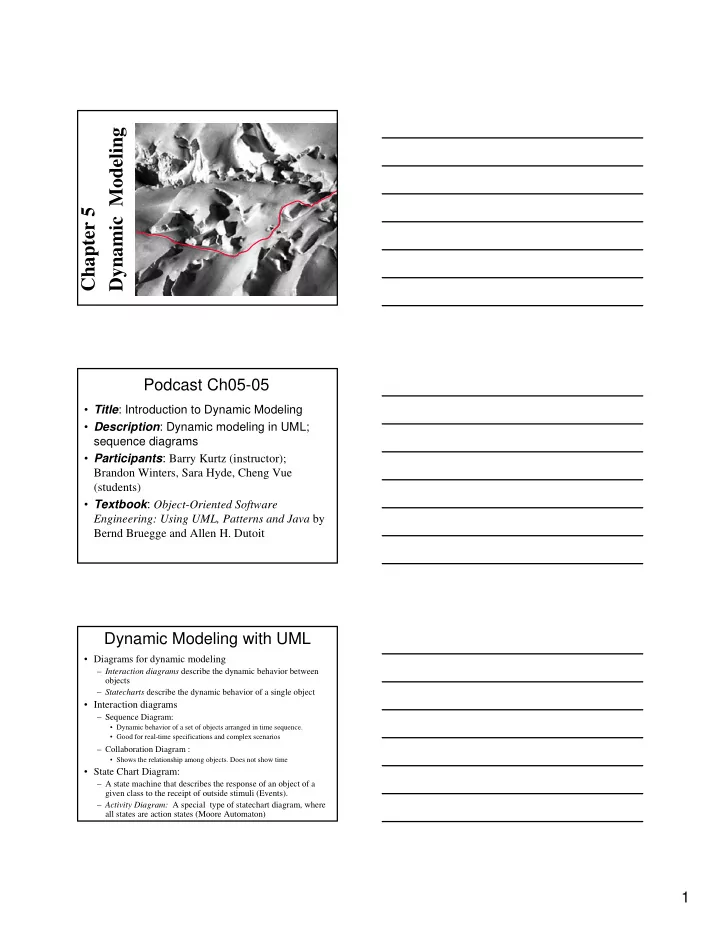

Dynamic Modeling Chapter 5 Podcast Ch05-05 • Title : Introduction to Dynamic Modeling • Description : Dynamic modeling in UML; sequence diagrams • Participants : Barry Kurtz (instructor); Brandon Winters, Sara Hyde, Cheng Vue (students) • Textbook : Object-Oriented Software Engineering: Using UML, Patterns and Java by Bernd Bruegge and Allen H. Dutoit Dynamic Modeling with UML • Diagrams for dynamic modeling – Interaction diagrams describe the dynamic behavior between objects – Statecharts describe the dynamic behavior of a single object • Interaction diagrams – Sequence Diagram: • Dynamic behavior of a set of objects arranged in time sequence. • Good for real-time specifications and complex scenarios – Collaboration Diagram : • Shows the relationship among objects. Does not show time • State Chart Diagram: – A state machine that describes the response of an object of a given class to the receipt of outside stimuli (Events). – Activity Diagram: A special type of statechart diagram, where all states are action states (Moore Automaton) 1
Dynamic Modeling • Definition of dynamic model: – A collection of multiple state chart diagrams, one state chart diagram for each class with important dynamic behavior. • Purpose: – Detect and supply methods for the object model • How do we do this? – Start with use case or scenario – Model interaction between objects => sequence diagram – Model dynamic behavior of a single object => statechart diagram Sequence Diagram • From the flow of events in the use case or scenario proceed to the sequence diagram • A sequence diagram is a graphical description of objects participating in a use case or scenario using a DAG (direct acyclic graph) notation • Relation to object identification: – Objects/classes have already been identified during object modeling – Objects are identified as a result of dynamic modeling • Heuristic: – A event always has a sender and a receiver. – The representation of the event is sometimes called a message – Find them for each event => These are the objects participating in the use case Heuristics for Sequence Diagrams • Layout: – 1st column: Should correspond to the actor who initiated the use case – 2nd column: Should be a boundary object – 3rd column: Should be the control object that manages the rest of the use case • Creation: – Control objects are created at the initiation of a use case – Boundary objects are created by control objects • Access: – Entity objects are accessed by control and boundary objects, – Entity objects should never call boundary or control objects: This makes it easier to share entity objects across use cases and makes entity objects resilient against technology- induced changes in boundary objects. 2
An ARENA Sequence Diagram : Create Tournament :Tournament :Arena Boundary League Owner newTournament(league) :Announce «new» Tournament Control checkMax Tournament() setName(name) setMaxPlayers(maxp) Impact on ARENA’s Object Model • Let’s assume, before we formulated the previous sequence diagram, ARENA’s object model contained the objects – League Owner, Arena, League, Tournament, Match and Player • The Sequence Diagram identified new Classes – Tournament Boundary, Announce_Tournament_Control League Owner League 1 * Attributes Attributes Operations Operations Tournament_ The Boundary Attributes New Operations Tournament Announce_ Classes Attributes Tournament_ Control Operations Attributes Operations Player Match * * Attributes Attributes Operations Operations 3
Impact on ARENA’s Object Model (ctd) • The Sequence Diagram also supplied us with a lot of new events – newTournament(league) – setName(name) – setMaxPlayers(max) – Commit – checkMaxTournaments() – createTournament • Question: Who owns these events? • Answer: For each object that receives an event there is a public operation in the associated class. – The name of the operation is usually the name of the event. Exercise ch05-05-01 • Your first extension to the Appalcart project is to allow the user select a bus stop from a map showing bus stops as pushpins. • Draw a sequence diagram for the selection process. • Did the sequence diagram introduce any new objects? Justify your response even if you answer “no”. 4
Recommend
More recommend